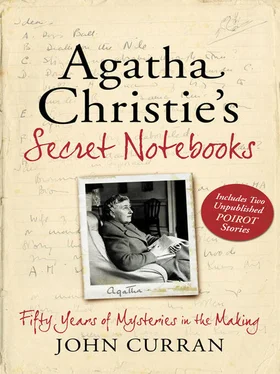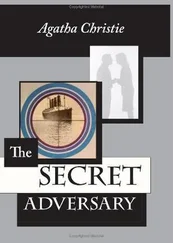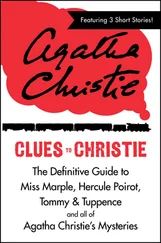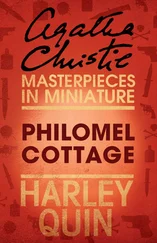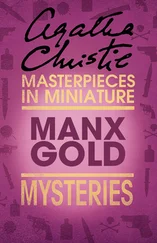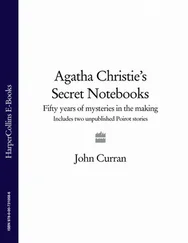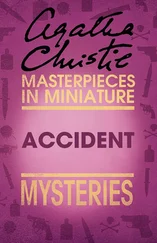Mrs McGinty’s Dead 3 March 1952
At the request of Superintendent Spence, Poirot agrees to reinvestigate the murder of charwoman Mrs McGinty, found battered to death two months earlier. Although James Bentley has been convicted of her murder, someone in Broadhinny is ready to kill again. And yet, they are all very nice people…
Continuing a pattern set two years earlier by A Murder is Announced, Mrs McGinty’s Dead is decidedly unglamorous, reflecting the post-war adjustment; it is one of Poirot’s rare ventures into the working class. ‘The Adventure of the Clapham Cook’ in 1923 was his earlier experience. The murder of a charwoman, appalling accommodation, an attempt on Poirot’s life and a completely uncharismatic defendant all combine to make Mrs McGinty’s Dead a particularly dark case.
There are more than 70 pages of notes for this novel. Names, motives, suspects, the earlier cases, the current possibilities all appear in chaotic profusion. As we saw in Chapter 3, the permutations and combinations of the four vitally important early cases and their possible incarnations as current inhabitants of Broadhinny are almost limitless; and all of them are considered.
On the first page Christie sets out the premise of the novel, leaving only the name of the superintendent to be decided:
Inspector ? [sic] old friend retiring worried about case just ending at the Old Bailey (or just sentenced sent for trial).
Not right—evidence all there—motive—opportunity and clues—but all wrong—his duty to get the facts—sent them to Public Prosecutor—there his responsibility ended. He can’t do any more…Can P do something?
Facts?
No facts. No-one else with motive—as a matter of fact, they’re all very nice people
She eventually settled on Superintendent Spence, Poirot’s partner in investigation from his previous case, Taken at the Flood, four years earlier. This was quite a big gap and the cover of the first edition of Mrs McGinty’s Dead is emblazoned—‘Poirot is Back!’
And over 30 years after her first novel, her powers of invention show no signs of deserting her. She sketches at least seven possible scenarios before settling on the fourth one below. It would seem that the title was already decided, probably because it is the name of a children’s game, albeit not a very well known one. It is quoted and described in Chapter 1 but only the title is utilised and there is no attempt to follow the rest of the verse. This was the one unalterable fact around which she effortlessly wove these ideas, any one of which would have made an acceptable plot. As can be seen, preliminary notes for this case first emerged as early as 1947, five years before the book’s appearance:
Mrs McGinty’s Dead
Mrs M is charwoman—middle aged office cleaner—because of something in wastepaper basket—she pieced together letters? Had taken something home
Morphia in the morning tea—
Flats! Lawn Road—only super—Mrs M is one of the cleaners
1947
A. Mrs McGinty’s Dead
Start Charwoman found dead in office—Lifted to sofa—later discovered strangled
Someone goes to break news at her home—real Mrs M is dead 6 months ago—this one is known to other cleaners as her sister in law
Why?
Who?
A woman of 50-60—Hands calloused—feet manicured—good underclothes
Mrs McGinty’s Dead
A. Mrs M is a charwoman. When investigated, it is found that she has no past history—she bribed former woman and took her place—her references were forged—17 Norton St. Birmingham—an accommodation address. What was she doing in Eleanor Lee’s office…Evidence for blackmail?
B. Mrs M is a char—‘does for’ the Remington family—lives in a little house by P.O.—takes a lodger—(James McBride) her savings broken open—Or hit on head—blood on James’s clothes—he tries to burn them in boiler.
C. Mrs M elderly middle-aged woman—lived with elderly husband James McGinty. Found killed—JM tells very peculiar story—(like Wallace) or is he nephew inherits money. Really young man cultivates her acquaintance—flatters her up—finally kills her in such a way J is bound to be suspected—Why?
Ideas for HP (Mrs McGinty)
4 or 5 people in household—one dangerous—P’s only clue—he is pushed at race meeting under horse’s hoof or train etc. by one of them. Mrs McGinty—(housekeeper?) leaves—is sent away—why? Later he finds her—she is dead
‘Wallace’ in item C above is a reference to the famous Julia Wallace murder case in Liverpool in 1931. Her husband, whose alibi could never be substantiated, was convicted of her murder but subsequently released. Like Mrs McGinty, Julia Wallace was found in her own sitting room with fatal head injuries.
All of the clues that appear in the book feature in Notebook 43—the bottle of ink and the letter, the newspaper cutting with its all-important mistake, the coffee cup, the sugar-cutter and Maureen Summerhayes’s very daring remark during the party:
Inkstain on the dead woman’s finger. Bought bottle of ink that afternoon at PO—no letter found. Newspaper—Daily Newshound or Evening Paper
Sugar cutter—Judge and wife brought them back—Vicarage sale of work
Real clue Robin
E. Kane changed her name to Hope—Evelyn Hope—girl—but not girl—boy. Robin’s ‘mother’ is not his mother—he got her name by deed poll—she was paid to give her name to him—later he kills her—does not want her to tell about past story
Robin’s method for second murder—has coffee cup with dregs and lipstick
The slip in paper—child not yet born—therefore sex not—known
Don’t like being adopted, do you? (A remark by Maureen Summerhayes at party)
And then she considers suspects…
Now consider each likely household
1. Married couple in late thirties—very vague—like R and A [Rosalind and Anthony, Christie’s daughter and son-in-law]—do market gardening—(he is son—or she is daughter of X) [possibly the Summerhayeses]
2. Invalid woman with son—son is artist—or does painted furniture or a writer—(detective stories?) [Mrs Upward and Robin]
3. Vaughans—unstable husband (banker or solicitor) quiet self-effacing wife—children?—one (son) hers by former marriage?
4. Rich woman wife very flashy—2 young men—live together—(one is son of X) has told stupid rich girl he is son of Russian Grand Duke
Not all of the previous cases which provide the motivation for a killer trying to conceal a criminal past appear in the Notebook as they do in the novel:
Edith Kane [Eva Kane/Evelyn Hope]
Went out that day—he poisoned Wife—a lot of gup in paper—all about that innocent child—betrayed—she and her child—the child born later—a daughter—the little daughter who never knew her father’s name. The new life for Edith Kane—went to Australia—or S. Africa—a new life in a new world.
She went—yes—but she came back 25 years ago
Janice Remington—acquitted of killing her husband or her lover like Madeleine Smith [Janice Courtland]
Little Lily Waterbrook—took chopper to aunt—detained—only fifteen—released later—Harris? [Lily Gamboll]
Greenwood Case—daughter—changed name—her evidence saved father—thirtyish
Newspaper suspects—Age now
55 Eva Kane (? changed name to Hope—went abroad—had s[on] or d[aughter]
45 Janice Crale—or The Tragic Wife—husband died of morphia—or bath—lover did it—unpleasant man—perverse—took drugs [Janice Courtland]
30 Lily Gamboll—killed aunt
The reference to ‘Madeleine Smith’ above relates to the case of a woman tried for poisoning her lover Emile L’Engelier in Glasgow in 1857. The verdict against Smith was ‘Not Proven’; in reality, it amounted to an acquittal. Like the Wallace case above, it is still the focus of keen speculation.
Читать дальше
Конец ознакомительного отрывка
Купить книгу
